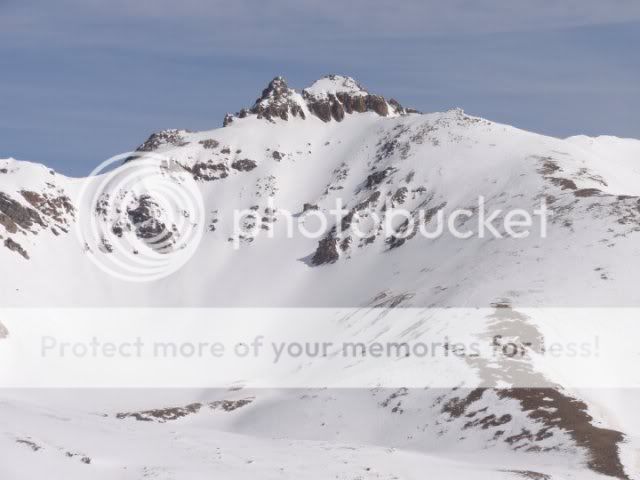In the spring of 2010, after several weeks of high pressure and warm temperatures, we were jonesing to get out for a tour. We set out from Loveland Ski Area's Dry Gulch backcountry gate, hoping that the prolonged period of calm had stabilized the snowpack.

We planned to traverse across upper Dry Gulch to the amphitheater between Hagar and Citadel, then ascend the mild southeast ridge of Citadel before descending its south bowl. Entering Dry Gulch, the views were incredible.
Citadel with Snoopy asleep on top:
Hagar:

Torreys and Grays:

Dry Gulch is big, here Ben is dwarfed by the fun north face of Golden Bear as we traverse towards Citadel.

Traversing from Loveland Basin to the Citadel-Hagar amphitheater took longer than expected; I think that accessing Dry Gulch from Loveland vs. I-70 is a draw. From the amphitheater we started gaining elevation. Nick:

We made quick work of the climb and an hour later we were beneath Citadel's rocky summit block. Jordan:

Looking south towards Hagar. Looks steep from here, doesn't it?

Knowing that a group of our friends would soon be catching us, we started our snow stability analysis of the south face. One step onto the face and I was immediately concerned - the snowpack appeared to be made entirely of facets. With a belay from Ben, I headed out to dig a pit, finding a snowpack consisting entirely of facets. I think these extensive facets were due to diurnal recrystallization. As the other group arrived, we decided the slope was unsafe.

At this point I didn't know what to do - the south face was a no go, and the north facing terrain harbored deep instabilities. The other group was led by a ski team coach who is a very loud, confident and dominant fellow. The coach suggested performing a cornice cut on the north facing terrain, which I helped with. None of the small cornice blocks produced any signs of instability as they rolled down the slope. In retrospect, I don't think they were large enough to test the slope. The coach loudly proclaimed that if there was a slide one should grab an exposed rock , or "ski like a bat out of hell". He decided that his group would be hiking a bit higher, then would descend the north facing terrain. We were left with a difficult situation: descend the mellow slope we had ascended or drop into the north facing bowl. And if we dropped, to go before the other group and avoid having them drop on top of us, or wait a prolonged period of time for them to hike higher, then drop after them. Feeling the pressure of the group dynamic, we decided to drop into the north facing terrain immediately.

Nothing moved as we skied consolidated powder down Citadel into Herman Gulch.

Looking back up the line, lookers left, from the bottom of Citadel's northeast amphitheater:

From Herman Gulch, a short skin brought us to the saddle back to Dry Gulch:

At the saddle we pulled off our skins and enjoyed 1500' of south facing corn to the floor of the gulch.

Ben:

Nick and Jordan:

Looking back on the line we skied on Citadel I still don't know if we made the safe choice.
What I do know:
1) There were deep instabilities, if we had triggered a slide it would have been huge.
2) On the steep, alpine terrain of Citadel there would have been no outrunning a slide.
3) Large groups inherently and significantly affect safe decision making.
Lessons learned:
1) Large groups produce the herding instinct - people feel safer in groups and are prone to making more dangerous decisions.
2) Don't let the loud member of the group drown out other people's opinions - so many factors (ego, shyness, competitiveness, etc) come into play in group settings. Its important for everyone to go out of their way to communicate with each member of the group; drawing on everyone's experience and knowledge.
3) Going home the way you came is always better than not going home at all.
The route:



No comments:
Post a Comment